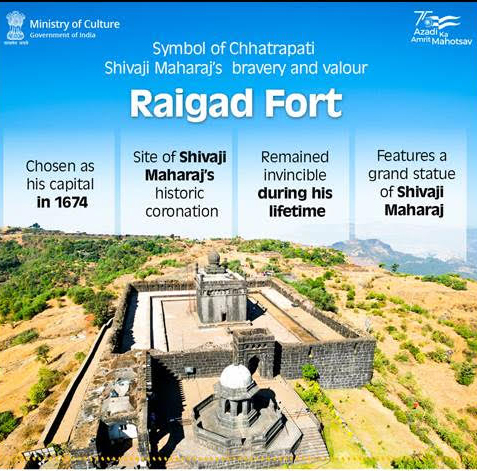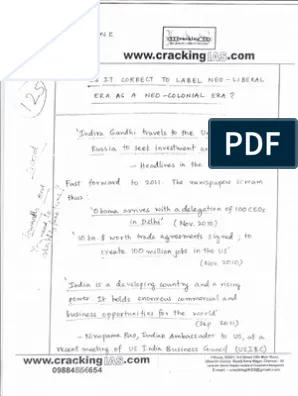- Home
- Prelims
- Mains
- Current Affairs
- Study Materials
- Test Series
 EDITORIALS & ARTICLES
EDITORIALS & ARTICLES
Chhaava - the real story of Sambhaji Maharaj
Chhatrapati Shivaji Maharaj''s path to establishing an independent Maratha empire was deeply intertwined with the political landscape of 17th-century India. Born into the esteemed Bhonsle family, he witnessed the decline of the Nizamshahi dynasty and the encroaching influence of both the Bijapur Sultanate and the Mughal Empire.
Chhatrapati Shivaji showed great political skill throughout his reign by combining bold actions against powerful adversaries with strategic diplomacy. His legacy includes administrative reforms, a strong military system, and the revival of Hindu traditions, establishing him as a skilled ruler and a symbol of Maratha pride.
Chhatrapati Shivaji Maharaj (1630-1680)
Chhatrapati Shivaji Maharaj was born on February 19, 1630, to Shahaji Bhosle and Jijabai at Shivneri Fort, located in the Pune district of Maharashtra. Shivaji established his independent kingdom by breaking away from the Sultanate of Bijapur which marked the beginning of the Maratha Confederacy.
Chhatrapati Shivaji established a strong and efficient government after taking power, supported by a well-trained army and a well-organized administrative system.
- In 1674, Shivaji was formally recognized as Chhatrapati of his kingdom at Raigad Fort.
- Chhatrapati Shivaji, known as the Father of the Indian Navy, was the first to recognize the significance of a naval force and built forts to defend the Konkan region of Maharashtra.
- He was referred to as the ''Mountain Rat'' and gained widespread recognition for his guerrilla warfare methods.
- Chhatrapati Shivaji, known for his honorable treatment of women, welcomed individuals from diverse castes and religions into his administration and armed forces, including both Muslims and Europeans.
- Early Life: Chhatrapati Shivaji''s formative years were significantly shaped by his mother, Jijabai, and his guardian, Dadoji Kondadeo.
- Jijabai''s influence cultivated in him a strong sense of religious and cultural identity.
- Dadaji Kondadev, entrusted with Shivaji''s upbringing, oversaw his education in administration, military strategy, and the intricacies of revenue systems.
- Chhatrapati Shivaji''s paternal grandfather, Maloji (1552–1597), served as a distinguished general in the Ahmadnagar Sultanate and received the honorific title of "Raja”.
- Maloji received Deshmukh rights for Pune, Supe, Chakan, and Indapur to support military expenses. Around 1590, he was awarded Fort Shivneri to serve as his family''s residence.
Wars and Conquests
When Chhatrapati Shivaji was born, the Deccan region was divided among three Muslim kingdoms: Bijapur, Ahmednagar, and Golkonda, as well as the Mughal Empire.
- He began his campaign against the Bijapur Sultanate in 1645 by capturing Torna Fort in 1646 at the age of 16.
- Chhatrapati Shivaji Maharaj, after the Battle of Purandar ( 1665 ), became a vassal of the Mughal Empire and briefly participated in military campaigns on their behalf.
- Shivaji became an expert in guerrilla warfare, known as "Ganimi Kawa" in Marathi. His tactics constantly surprised and defeated the armies sent against him.
Conflict with Bijapur Sultanate
Chhatrapati Shivaji''s father, Shahaji, was a rebel against the Mughal Empire who sought opportunities for land grants in the Bijapur Sultanate.
- ChhatrapatiShivaji was born during a period of instability and frequent relocation due to his father''s conflicts with the Mughals. In 1636, the Adil Shahi Sultanate of Bijapur launched an invasion of the southern kingdoms, aided by Shahaji.
- Shahaji, who had received Poona as a grant, placed Dadoji Kondadeo in charge of its administration.
- He was deployed to Bangalore by Bijapur Sultanate Adil Shah while Chhatrapati Shivaji and his mother, Jijabai, settled in Poona.
- After Kondadeo died in 1647, ChhatrapatiShivaji Maharaj took control of Poona. One of his first actions was to oppose the Bijapur government directly.
- Conflict: Chhatrapati Shivaji Maharaj began his rise to power by capturing Torna Fort in 1646 amidst the turmoil in the Bijapur court.
- He continued his expansion by capturing key forts and towns near Pune including Purandar, Kondhana, and Chakan.
- Chhatrapati Shivaji Maharaj established his headquarters at Rajgad.
- The Bijapur government, alarmed by his growing power, imprisoned his father, Shahaji on July 25, 1648.
- Following Shahaji''s release in 1649, Chhatrapati Shivaji resumed his raids.
- He killed Chandra Rao More, a fellow Maratha vassal of Bijapur, which facilitated further conquests.
- To consolidate his power, Chhatrapati Shivaji Maharaj brought several powerful families under his control through various strategies such as marriage alliances, direct dealings with village leaders, and force.
- However, after the death of Shahaji around 1664-1665, the Bijapur government, dissatisfied with the losses to Shivaji''s forces, sent Afzal Khan to arrest him in 1657.
- Battle of Pratapgarh ( 1659 ): The Battle of Pratapgad occurred on November 10, 1659, at Pratapgarh Fort in Satara. The battle took place between Chhatrapati Shivaji''s Maratha army and the Bijapur forces commanded by General Afzal Khan.
- The Marathas secured a decisive victory, marking their first major military success against a prominent regional power.
- Capture of Panhala Fort: After overcoming Bijapuri forces in 1659, Chhatrapati Shivaji advanced to the Konkan coast and Kolhapur, capturing Panhala Fort.
- In 1660, Siddi Jauhar, a general of Adilshah, besieged Panhala with the support of the Mughals.
- After months of siege, Chhatrapati Shivaji surrendered the Panhala fort on September 22, 1660.
- He then moved to Vishalgad and later recaptured Panhala in 1673.
- Battle of Pavan Khind ( 1660 ): The Battle of Pavan Khind occurred on July 13, 1660, with Maratha leaders facing Siddi Masud of the Bijapur Sultanate.
- The battle resulted in the defeat of the Marathas but the Bijapur Sultanate did not accomplish its overall objectives.
- Ghod Khind was later referred to as Paavan Khind.
Conflict With Mughal Empire
Chhatrapati Shivaji initially allied with the Mughals but later rebelled and attacked Mughal territory in 1657. In response, Aurangzeb sent Nasiri Khan against ChhatrapatiShivaji, but his efforts were hindered by the rainy season and conflict over the throne.
- Battle of Chakan ( 1660 ): The Battle of Chakan in 1660 occurred between Mughal forces under Shaista Khan and Maratha troops under Firangoji Narsala at Chakan in Maharashtra which ultimately forced Maratha commander Firangoji to capitulate.
- Battle of Surat ( 1664 ): Chhatrapati Shivaji Maharaj attacked Shaista Khan''s camp in 1663, injuring Khan and forcing him to flee.
- In retaliation, Chhatrapati Shivaji raided Surat in 1664 and Basrur in 1665.
- Treaty of Purandar ( 1665 ): Aurangzeb was infuriated by Chhatrapati Shivaji''s assaults on Shaista Khan and Surat. To counter this, he dispatched Jai Singh along with an army to defeat Shivaji.
- Shivaji, facing a formidable Mughal army, negotiated and signed the Treaty of Purandar in 1665.
- As part of the treaty, Shivaji agreed to Mughal authority and sent his son Sambhaji to serve as a mansabdar in the Mughal court.
- Shivaji''s Detention in Agra and Escape: Aurangzeb calledChhatrapati Shivaji Maharaj and his son Sambhaji to his court in Agra in 1666. During the proceedings, Chhatrapati Shivaji was dishonored and subsequently placed under house arrest.
- However, on August 17, 1666, Chhatrapati Shivaji Maharaj escaped with his son Sambhaji.
- Peace with Mughals: Following Chhatrapati Shivaji''s departure from Agra, tensions with the Mughals eased. Jaswant Singh served as a mediator for peace between Chhatrapati Shivaji and Aurangzeb.
- Aurangzeb bestowed the title of raja upon Chhatrapati Shivaji and reinstated Sambhaji as a Mughal mansabdar between 1666 and 1668.
- Battle of Sinhagad or Kondhana ( 1670 ): The Battle of Sinhagadwas fought between Marathas led by Tanaji and Mughals near Pune in Maharashtra. Chhatrapati Shivaji took back Sinhagad fort from the Mughals.
- Battle of Salher ( 1672 ): The Battle of Salher took place between the Marathas and the Mughals near Salher Fort in Nashik district in 1672. The battle is considered important as it marked the first major victory for the Marathas against the Mughal Empire.
Conquests in Southern India
Beginning in 1674, Marathas attacked Khandesh and captured Bijapuri Ponda, Karwar, and Kolhapur. The Maratha navy clashed with the Siddis of Janjira but couldn’t drive them out.
- After getting better from an illness and capitalizing on a civil war in Bijapur, Chhatrapati Shivaji Maharaj campaigned against Athani in April 1676.
- Chhatrapati Shivaji urged the people of Southern India to unite against external threats, resulting in a successful treaty with the Qutubshah of Golkonda in 1677.
Administration
Chhatrapati Shivaji Maharaj was crowned in 1674 at the Raigad Fort in present-day Maharashtra, India. During this event, he established a council of eight ministers to assist in managing his new state, known as the Ashta Pradhan.
- Ashta Pradhan: The Ashta Pradhan, a council of eight ministers, served as the cabinet for the Maratha Confederacy. Each minister had specific responsibilities, including administration, finance, military, foreign affairs, justice, and religion.
- The titles of the ministers were derived from the Sanskrit language.
- While the Panditrao and Nyayadhis focused on religious and legal matters, the other ministers also had military roles.
- Their civil responsibilities were frequently handled by deputies.
Ashta Pradhan is noted for introducing effective governance in the Maratha region and for its role in the Marathas'' military efforts against the Mughal Empire.
- Advocacy of Marathi and Sanskrit: Chhatrapati Shivaji Maharaj promoted Marathi as a formal language and appointed an official to compile a glossary to replace Persian and Arabic words with their Sanskrit equivalents.
- Chhatrapati Shivaji Maharaj used Sanskrit for his official seal. Seal was used to validate documents.
- Religious Policies: Chhatrapati Shivaji promoted religious harmony and formed alliances with Muslim states.
- Chhatrapati Shivaji’s army included Muslim leaders, like Darya Sarang, a prominent commander.
- Chhatrapati Shivaji Maharaj lived during the same time as Samarth Ramdas, a Brahmin teacher.
Warfare Strategy
Aurangzeb and his generals referred to Chhatrapati Shivaji as a "Mountain Rat" because of his guerrilla methods of ambushing enemy forces and then retreating to his mountain forts. He took advantage of the local landscape and maintained a small but effective army, mainly made up of peasants from the Maratha and Kunbi castes.
- Military: Shivaji’s military approach centered on employing his ground and naval forces, along with a network of forts throughout the region.
- The Maval infantry formed the backbone of his ground forces and was accompanied by Maratha cavalry.
- He had basic artillery and depended on European providers.
- Hill Forts: Hill forts were essential to Shivaji''s strategy. He seized and constructed numerous forts, including Adilshahi forts at Murambdev ( Rajgad ), Torna, Kondhana ( Sinhagad ), and Purandar.
- Chhatrapati Shivaji Maharaj assigned three officers to oversee their security.
- Chhatrapati Shivaji controlled approximately 240 to 280 forts by the time of his death.
- Navy: ChhatrapatiShivaji Maharaj recognized the need for naval power to control the Konkan coast and began building his navy by capturing and repairing coastal forts.
- He recruited lower-caste Hindus skilled in naval operations, referred to as the "Malabar pirates," along with Muslim mercenaries.
- He built his first marine fort at Sindhudurg, which became the headquarters of the Maratha navy.
Successors
Chhatrapati Shivaji Maharaj had two sons, Sambhaji and Rajaram, who were half-brothers from different mothers. After ChhatrapatiShivaji Maharaj died in 1681, Sambhaji inherited the throne and continued pursuing his father''s expansionist ambitions.
- Sambhaji was later captured and executed by the Mughals.
- Rajaram then took the throne but was forced to flee to Ginjee Fort by the Mughals. He later died at Satara.
- Rajaram’s young son, Shivaji II (Ramaraja), succeeded him with his mother, Tara Bai, as regent.
- The next ruler, Shahu, son of Sambaji saw the rise of the Peshwas to power.
- In 1713, Shahu designated Balaji Vishwanath as the Peshwa.
|
What is Lezim?
|
Sambhaji Maharaj
- Sambhaji Maharaj was the oldest son of the founder of Maratha kingdom, Chhatrapati Shivaji Maharaj. The second ruler of the kingdom after his father’s death, he ruled for nine years and gained recognition for his valour and patriotism.
- He ruled from 1681 to 1689. His rule was largely shaped by the ongoing wars between the Marathas and the Mughal Empire, Siddi of Janjira, Wadiyars of Mysore, and the Portuguese Empire.
- Among the major military campaigns launched by Sambhaji Maharaj was the attack on Burhanpur, an important Mughal city in present-day Madhya Pradesh and a trading centre. He did this to stop Aurangzeb from expanding his footprint in the Deccan.
- Multiple battles took place between the two sides from 1682 and 1688. While the Mughals wanted control over forts held by Marathas, they were not successful.
- Two years after he came to power, Sambhaji aka Sambhuraje executed about 24 members of influential families after he discovered that certain people were plotting his assassination. By 1685, Mughals had pushed back Sambhaji and had taken over his strongholds. Three years later, they captured him and executed him.
- On February 1, 1689, Aurangzeb captured him by deception and harassed him for days before executing him in the ‘most horrible’ manner possible. However, Sambhaji won a place of honour in everyone’s hearts for his incredible bravery in confronting death to defend three of his most prized possessions: Deva, Desh, and Dharma. People of Maharashtra recognise the hero and respect his refusal to succumb to Aurangzeb’s methods, preferring to die over compromising the cause he believed in. Sambhaji was executed on March 11, 1689.
|
Maratha Military Landscapes of India
|
6 forts that define Maratha bravery
Raigad Fort - Perched in the Sahyadris, Raigad Fort was Shivaji Maharaj’s capital and the site of his grand coronation in 1674. Its massive gates, palaces, and tombs symbolize the Maratha Empire’s glory.
|
Location |
• Situated in the Sahyadri mountain range in Maharashtra, India. |
|
Background |
• Originally known as Rairi. |
|
Significance |
• Part of the “Maratha Military Landscapes of India” nomination for UNESCO World Heritage status. |
|
Architectural Highlights |
• Includes the Royal Complex with key structures like Ranivasa and Rajsadar. |
|
Features |
• Accessible mainly through Naqqarkhana and Palkhi Darwaja. |
|
Ecology |
• Surrounded by valleys shaped by the Kal and Gandhari rivers. |
|
Cultural Significance |
• Known as the Durgaraj (King of Forts), symbolizing Shivaji Maharaj’s legacy. |

Sinhagad Fort -Sinhagad Fort, near Pune, is famed for Tanaji Malusare’s sacrifice in the Battle of Sinhagad (1670). This hilltop fortress offers scenic views, historic bastions, and tales of Maratha valor.
Pratapgad Fort - Pratapgad Fort witnessed Shivaji’s legendary battle against Afzal Khan in 1659. Its watchtowers, pathways, and strong fortifications reflect the Maratha warrior’s strategic brilliance in securing their kingdom’s frontiers.
Shivneri Fort - Shivneri Fort, the birthplace of Chhatrapati Shivaji Maharaj, holds immense historical significance. Its ancient gates, water reservoirs, and Shivai Devi temple echo the childhood and early inspirations of the great leader.
Lohgad Fort - Lohgad Fort, meaning “Iron Fort,” was a key stronghold of the Marathas. With its massive gates, intricate water systems, and panoramic views, it played a crucial role in Shivaji’s military campaigns.
Panhala Fort - Panhala Fort, the largest in Deccan, was a stronghold of Maratha resistance. Its massive ramparts, Ambarkhana granaries, and Andhar Bavadi showcase Maratha military brilliance and resilience against enemies.
|
Sambhaji
After Sambhaji
|









 Latest News
Latest News General Studies
General Studies